Analyzing Team Effectiveness and Organizational Behaviour at ASDA
VerifiedAdded on 2023/06/08
|8
|2005
|377
Report
AI Summary
This report analyzes workforce motivation and team effectiveness within ASDA, a multinational retail organization. It contrasts effective and ineffective teams, highlighting the importance of clarity in organizational goals, communication, and conflict resolution. The report applies concepts and philosophies of organizational behaviour, including individual differences, perception, motivation, and empowerment, to understand how they influence ASDA's operations. It also examines different leadership styles such as autocratic, custodial, collegial, and supportive leadership, and their impact on team performance and employee empowerment. The study concludes that understanding and applying these principles are crucial for ASDA to achieve its objectives and maintain a motivated and productive workforce.
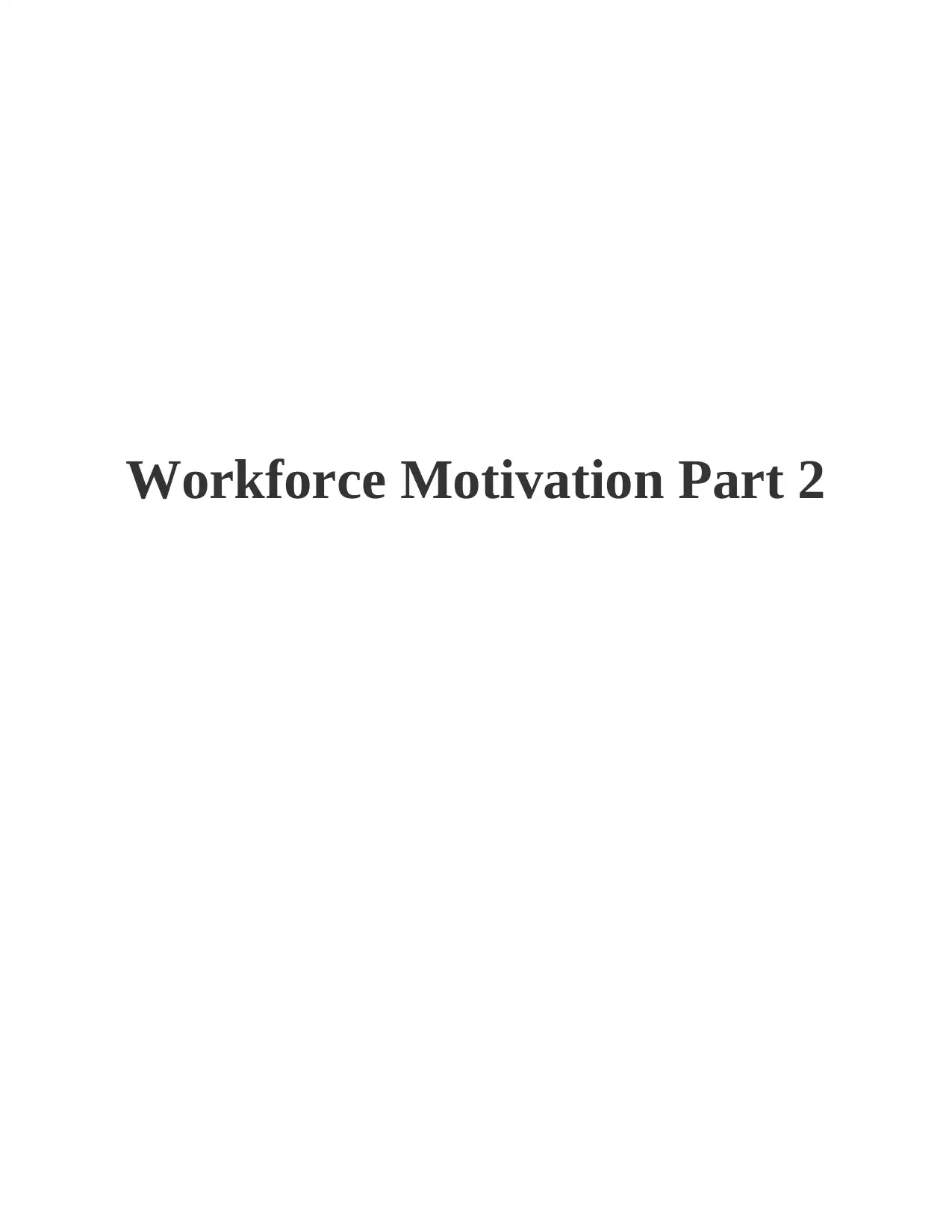
Workforce Motivation Part 2
Paraphrase This Document
Need a fresh take? Get an instant paraphrase of this document with our AI Paraphraser
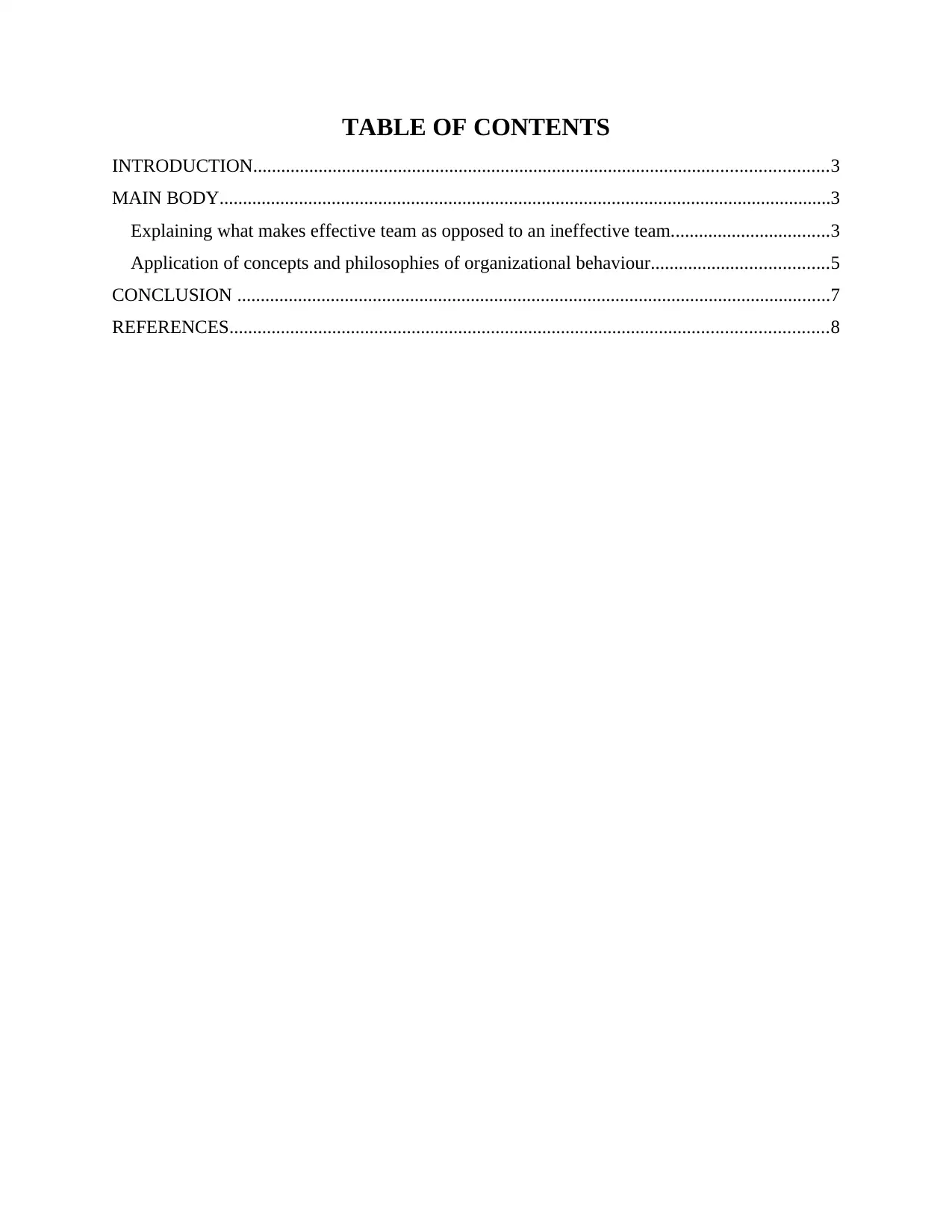
TABLE OF CONTENTS
INTRODUCTION...........................................................................................................................3
MAIN BODY...................................................................................................................................3
Explaining what makes effective team as opposed to an ineffective team..................................3
Application of concepts and philosophies of organizational behaviour......................................5
CONCLUSION ...............................................................................................................................7
REFERENCES................................................................................................................................8
INTRODUCTION...........................................................................................................................3
MAIN BODY...................................................................................................................................3
Explaining what makes effective team as opposed to an ineffective team..................................3
Application of concepts and philosophies of organizational behaviour......................................5
CONCLUSION ...............................................................................................................................7
REFERENCES................................................................................................................................8
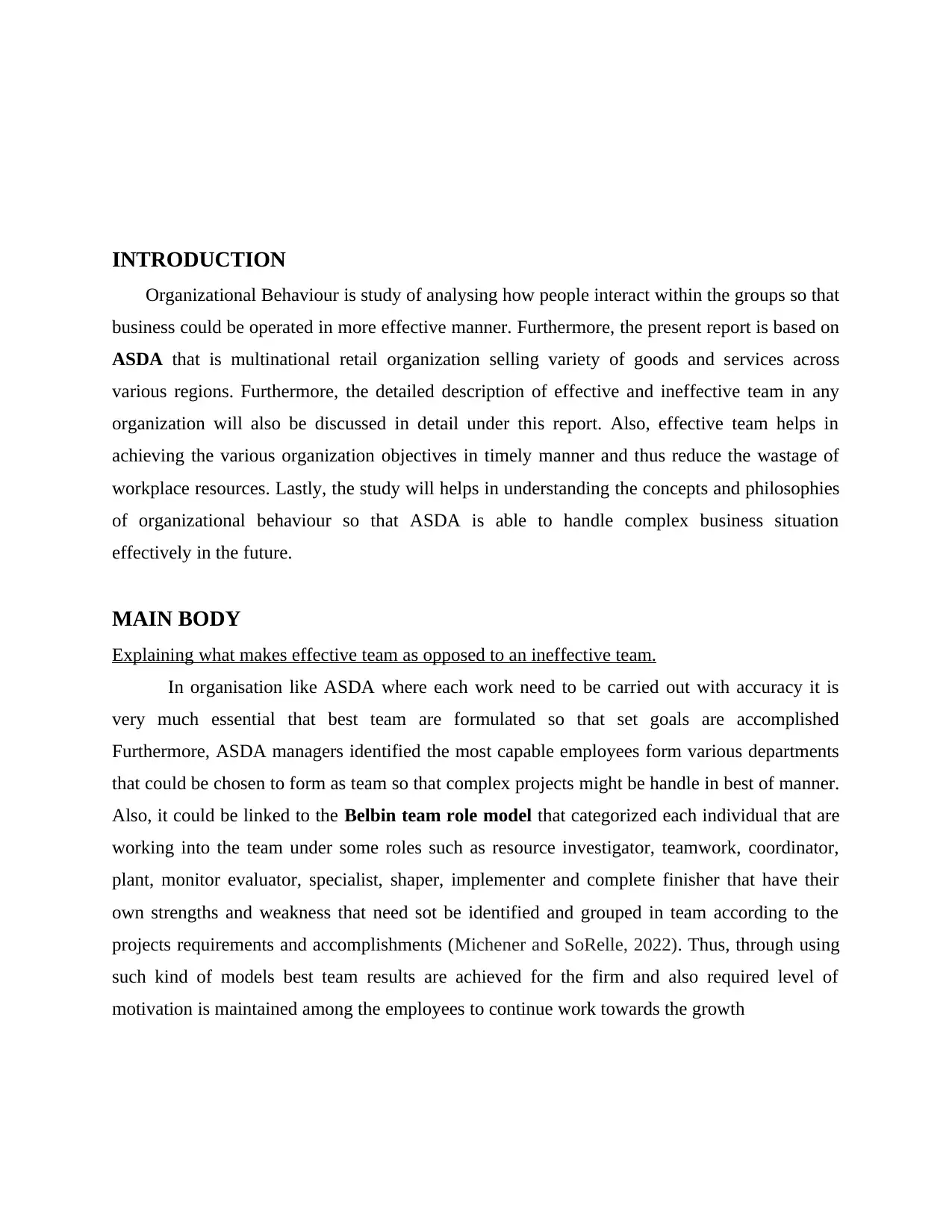
INTRODUCTION
Organizational Behaviour is study of analysing how people interact within the groups so that
business could be operated in more effective manner. Furthermore, the present report is based on
ASDA that is multinational retail organization selling variety of goods and services across
various regions. Furthermore, the detailed description of effective and ineffective team in any
organization will also be discussed in detail under this report. Also, effective team helps in
achieving the various organization objectives in timely manner and thus reduce the wastage of
workplace resources. Lastly, the study will helps in understanding the concepts and philosophies
of organizational behaviour so that ASDA is able to handle complex business situation
effectively in the future.
MAIN BODY
Explaining what makes effective team as opposed to an ineffective team.
In organisation like ASDA where each work need to be carried out with accuracy it is
very much essential that best team are formulated so that set goals are accomplished
Furthermore, ASDA managers identified the most capable employees form various departments
that could be chosen to form as team so that complex projects might be handle in best of manner.
Also, it could be linked to the Belbin team role model that categorized each individual that are
working into the team under some roles such as resource investigator, teamwork, coordinator,
plant, monitor evaluator, specialist, shaper, implementer and complete finisher that have their
own strengths and weakness that need sot be identified and grouped in team according to the
projects requirements and accomplishments (Michener and SoRelle, 2022). Thus, through using
such kind of models best team results are achieved for the firm and also required level of
motivation is maintained among the employees to continue work towards the growth
Organizational Behaviour is study of analysing how people interact within the groups so that
business could be operated in more effective manner. Furthermore, the present report is based on
ASDA that is multinational retail organization selling variety of goods and services across
various regions. Furthermore, the detailed description of effective and ineffective team in any
organization will also be discussed in detail under this report. Also, effective team helps in
achieving the various organization objectives in timely manner and thus reduce the wastage of
workplace resources. Lastly, the study will helps in understanding the concepts and philosophies
of organizational behaviour so that ASDA is able to handle complex business situation
effectively in the future.
MAIN BODY
Explaining what makes effective team as opposed to an ineffective team.
In organisation like ASDA where each work need to be carried out with accuracy it is
very much essential that best team are formulated so that set goals are accomplished
Furthermore, ASDA managers identified the most capable employees form various departments
that could be chosen to form as team so that complex projects might be handle in best of manner.
Also, it could be linked to the Belbin team role model that categorized each individual that are
working into the team under some roles such as resource investigator, teamwork, coordinator,
plant, monitor evaluator, specialist, shaper, implementer and complete finisher that have their
own strengths and weakness that need sot be identified and grouped in team according to the
projects requirements and accomplishments (Michener and SoRelle, 2022). Thus, through using
such kind of models best team results are achieved for the firm and also required level of
motivation is maintained among the employees to continue work towards the growth
⊘ This is a preview!⊘
Do you want full access?
Subscribe today to unlock all pages.

Trusted by 1+ million students worldwide
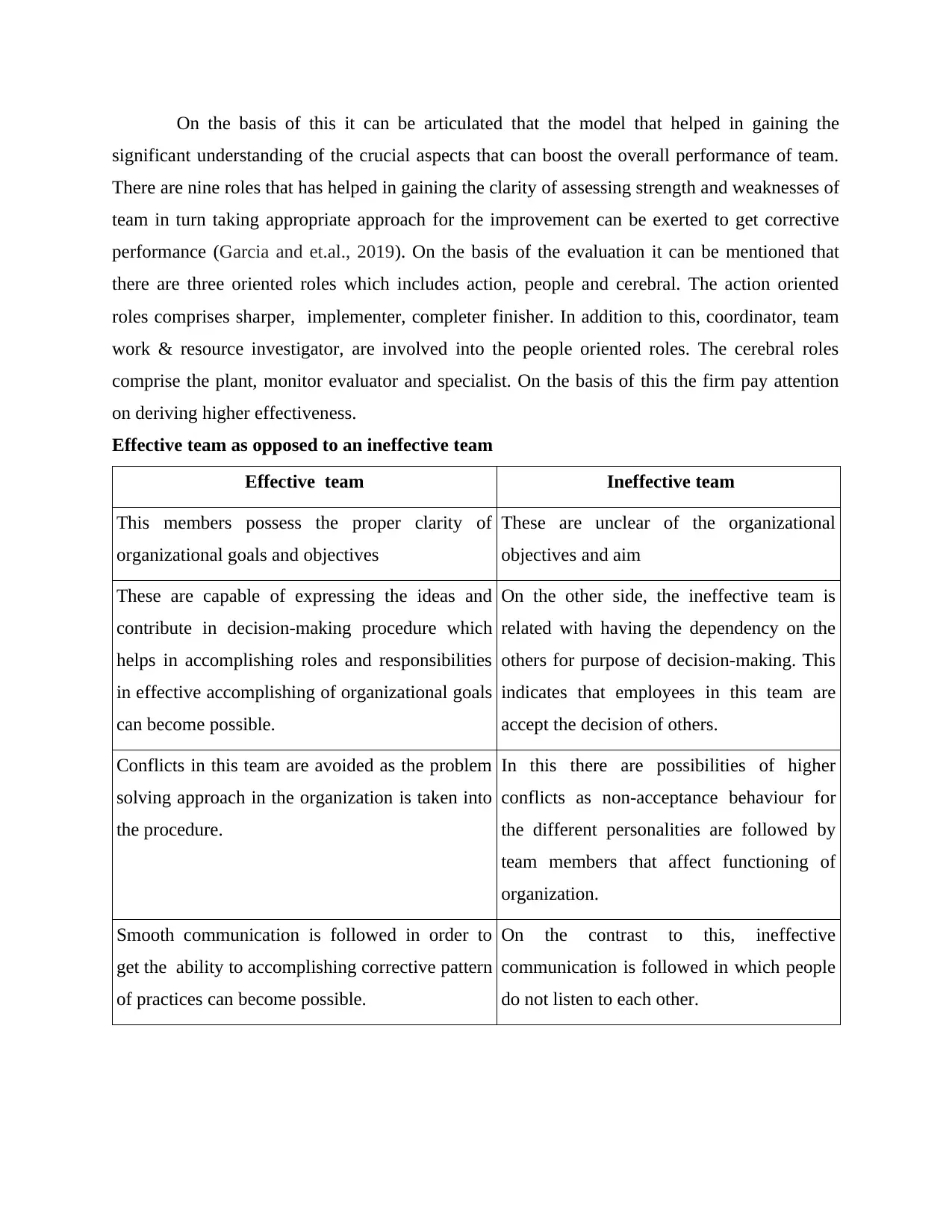
On the basis of this it can be articulated that the model that helped in gaining the
significant understanding of the crucial aspects that can boost the overall performance of team.
There are nine roles that has helped in gaining the clarity of assessing strength and weaknesses of
team in turn taking appropriate approach for the improvement can be exerted to get corrective
performance (Garcia and et.al., 2019). On the basis of the evaluation it can be mentioned that
there are three oriented roles which includes action, people and cerebral. The action oriented
roles comprises sharper, implementer, completer finisher. In addition to this, coordinator, team
work & resource investigator, are involved into the people oriented roles. The cerebral roles
comprise the plant, monitor evaluator and specialist. On the basis of this the firm pay attention
on deriving higher effectiveness.
Effective team as opposed to an ineffective team
Effective team Ineffective team
This members possess the proper clarity of
organizational goals and objectives
These are unclear of the organizational
objectives and aim
These are capable of expressing the ideas and
contribute in decision-making procedure which
helps in accomplishing roles and responsibilities
in effective accomplishing of organizational goals
can become possible.
On the other side, the ineffective team is
related with having the dependency on the
others for purpose of decision-making. This
indicates that employees in this team are
accept the decision of others.
Conflicts in this team are avoided as the problem
solving approach in the organization is taken into
the procedure.
In this there are possibilities of higher
conflicts as non-acceptance behaviour for
the different personalities are followed by
team members that affect functioning of
organization.
Smooth communication is followed in order to
get the ability to accomplishing corrective pattern
of practices can become possible.
On the contrast to this, ineffective
communication is followed in which people
do not listen to each other.
significant understanding of the crucial aspects that can boost the overall performance of team.
There are nine roles that has helped in gaining the clarity of assessing strength and weaknesses of
team in turn taking appropriate approach for the improvement can be exerted to get corrective
performance (Garcia and et.al., 2019). On the basis of the evaluation it can be mentioned that
there are three oriented roles which includes action, people and cerebral. The action oriented
roles comprises sharper, implementer, completer finisher. In addition to this, coordinator, team
work & resource investigator, are involved into the people oriented roles. The cerebral roles
comprise the plant, monitor evaluator and specialist. On the basis of this the firm pay attention
on deriving higher effectiveness.
Effective team as opposed to an ineffective team
Effective team Ineffective team
This members possess the proper clarity of
organizational goals and objectives
These are unclear of the organizational
objectives and aim
These are capable of expressing the ideas and
contribute in decision-making procedure which
helps in accomplishing roles and responsibilities
in effective accomplishing of organizational goals
can become possible.
On the other side, the ineffective team is
related with having the dependency on the
others for purpose of decision-making. This
indicates that employees in this team are
accept the decision of others.
Conflicts in this team are avoided as the problem
solving approach in the organization is taken into
the procedure.
In this there are possibilities of higher
conflicts as non-acceptance behaviour for
the different personalities are followed by
team members that affect functioning of
organization.
Smooth communication is followed in order to
get the ability to accomplishing corrective pattern
of practices can become possible.
On the contrast to this, ineffective
communication is followed in which people
do not listen to each other.
Paraphrase This Document
Need a fresh take? Get an instant paraphrase of this document with our AI Paraphraser
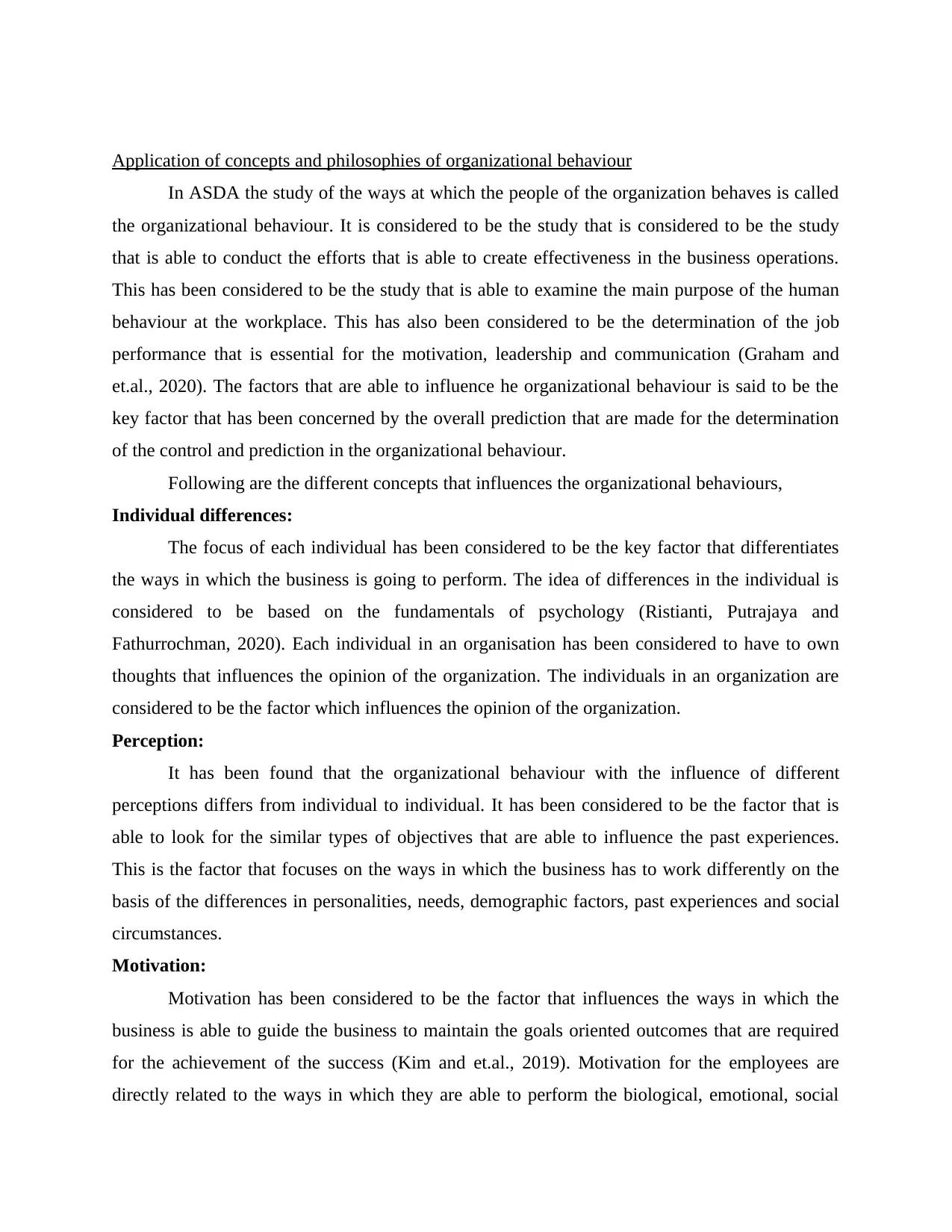
Application of concepts and philosophies of organizational behaviour
In ASDA the study of the ways at which the people of the organization behaves is called
the organizational behaviour. It is considered to be the study that is considered to be the study
that is able to conduct the efforts that is able to create effectiveness in the business operations.
This has been considered to be the study that is able to examine the main purpose of the human
behaviour at the workplace. This has also been considered to be the determination of the job
performance that is essential for the motivation, leadership and communication (Graham and
et.al., 2020). The factors that are able to influence he organizational behaviour is said to be the
key factor that has been concerned by the overall prediction that are made for the determination
of the control and prediction in the organizational behaviour.
Following are the different concepts that influences the organizational behaviours,
Individual differences:
The focus of each individual has been considered to be the key factor that differentiates
the ways in which the business is going to perform. The idea of differences in the individual is
considered to be based on the fundamentals of psychology (Ristianti, Putrajaya and
Fathurrochman, 2020). Each individual in an organisation has been considered to have to own
thoughts that influences the opinion of the organization. The individuals in an organization are
considered to be the factor which influences the opinion of the organization.
Perception:
It has been found that the organizational behaviour with the influence of different
perceptions differs from individual to individual. It has been considered to be the factor that is
able to look for the similar types of objectives that are able to influence the past experiences.
This is the factor that focuses on the ways in which the business has to work differently on the
basis of the differences in personalities, needs, demographic factors, past experiences and social
circumstances.
Motivation:
Motivation has been considered to be the factor that influences the ways in which the
business is able to guide the business to maintain the goals oriented outcomes that are required
for the achievement of the success (Kim and et.al., 2019). Motivation for the employees are
directly related to the ways in which they are able to perform the biological, emotional, social
In ASDA the study of the ways at which the people of the organization behaves is called
the organizational behaviour. It is considered to be the study that is considered to be the study
that is able to conduct the efforts that is able to create effectiveness in the business operations.
This has been considered to be the study that is able to examine the main purpose of the human
behaviour at the workplace. This has also been considered to be the determination of the job
performance that is essential for the motivation, leadership and communication (Graham and
et.al., 2020). The factors that are able to influence he organizational behaviour is said to be the
key factor that has been concerned by the overall prediction that are made for the determination
of the control and prediction in the organizational behaviour.
Following are the different concepts that influences the organizational behaviours,
Individual differences:
The focus of each individual has been considered to be the key factor that differentiates
the ways in which the business is going to perform. The idea of differences in the individual is
considered to be based on the fundamentals of psychology (Ristianti, Putrajaya and
Fathurrochman, 2020). Each individual in an organisation has been considered to have to own
thoughts that influences the opinion of the organization. The individuals in an organization are
considered to be the factor which influences the opinion of the organization.
Perception:
It has been found that the organizational behaviour with the influence of different
perceptions differs from individual to individual. It has been considered to be the factor that is
able to look for the similar types of objectives that are able to influence the past experiences.
This is the factor that focuses on the ways in which the business has to work differently on the
basis of the differences in personalities, needs, demographic factors, past experiences and social
circumstances.
Motivation:
Motivation has been considered to be the factor that influences the ways in which the
business is able to guide the business to maintain the goals oriented outcomes that are required
for the achievement of the success (Kim and et.al., 2019). Motivation for the employees are
directly related to the ways in which they are able to perform the biological, emotional, social
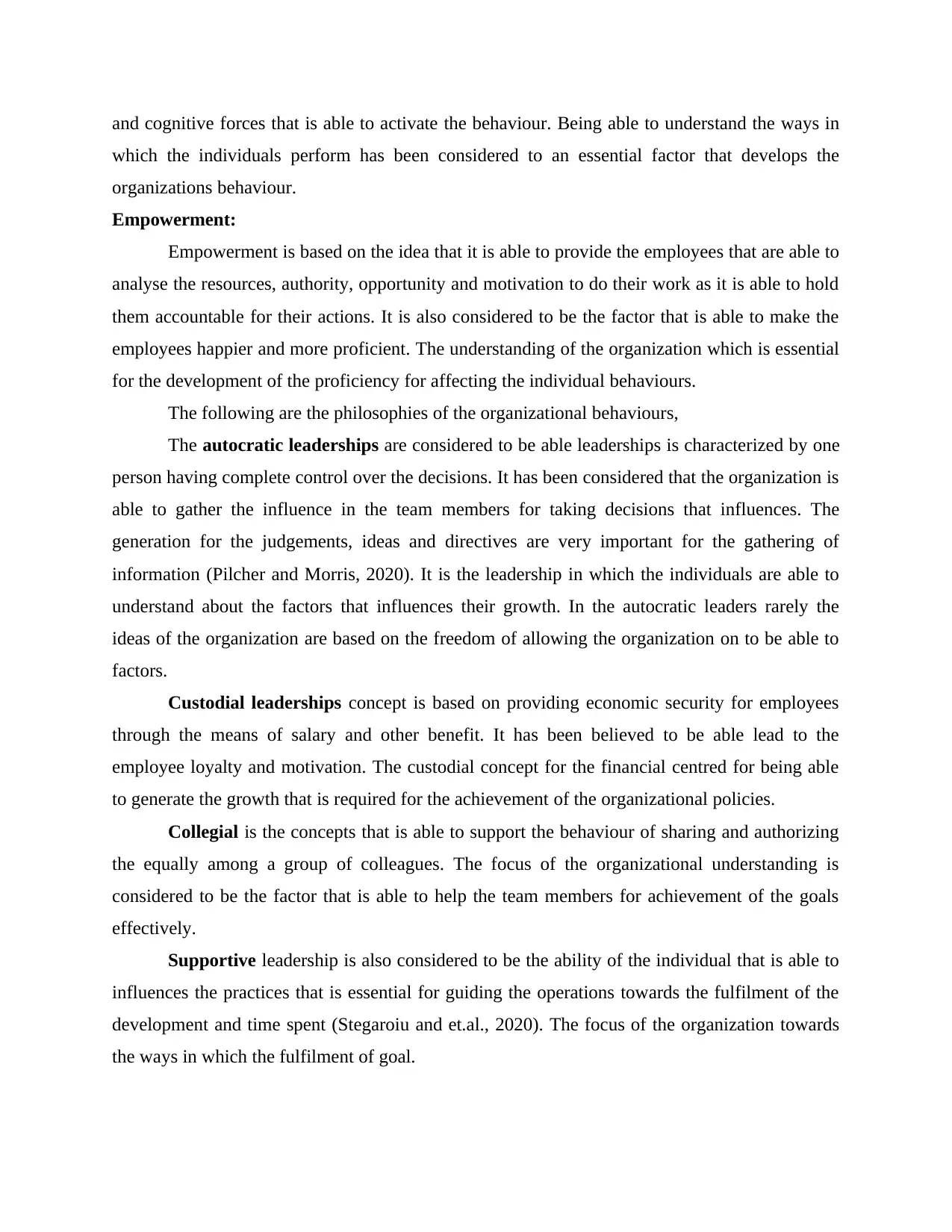
and cognitive forces that is able to activate the behaviour. Being able to understand the ways in
which the individuals perform has been considered to an essential factor that develops the
organizations behaviour.
Empowerment:
Empowerment is based on the idea that it is able to provide the employees that are able to
analyse the resources, authority, opportunity and motivation to do their work as it is able to hold
them accountable for their actions. It is also considered to be the factor that is able to make the
employees happier and more proficient. The understanding of the organization which is essential
for the development of the proficiency for affecting the individual behaviours.
The following are the philosophies of the organizational behaviours,
The autocratic leaderships are considered to be able leaderships is characterized by one
person having complete control over the decisions. It has been considered that the organization is
able to gather the influence in the team members for taking decisions that influences. The
generation for the judgements, ideas and directives are very important for the gathering of
information (Pilcher and Morris, 2020). It is the leadership in which the individuals are able to
understand about the factors that influences their growth. In the autocratic leaders rarely the
ideas of the organization are based on the freedom of allowing the organization on to be able to
factors.
Custodial leaderships concept is based on providing economic security for employees
through the means of salary and other benefit. It has been believed to be able lead to the
employee loyalty and motivation. The custodial concept for the financial centred for being able
to generate the growth that is required for the achievement of the organizational policies.
Collegial is the concepts that is able to support the behaviour of sharing and authorizing
the equally among a group of colleagues. The focus of the organizational understanding is
considered to be the factor that is able to help the team members for achievement of the goals
effectively.
Supportive leadership is also considered to be the ability of the individual that is able to
influences the practices that is essential for guiding the operations towards the fulfilment of the
development and time spent (Stegaroiu and et.al., 2020). The focus of the organization towards
the ways in which the fulfilment of goal.
which the individuals perform has been considered to an essential factor that develops the
organizations behaviour.
Empowerment:
Empowerment is based on the idea that it is able to provide the employees that are able to
analyse the resources, authority, opportunity and motivation to do their work as it is able to hold
them accountable for their actions. It is also considered to be the factor that is able to make the
employees happier and more proficient. The understanding of the organization which is essential
for the development of the proficiency for affecting the individual behaviours.
The following are the philosophies of the organizational behaviours,
The autocratic leaderships are considered to be able leaderships is characterized by one
person having complete control over the decisions. It has been considered that the organization is
able to gather the influence in the team members for taking decisions that influences. The
generation for the judgements, ideas and directives are very important for the gathering of
information (Pilcher and Morris, 2020). It is the leadership in which the individuals are able to
understand about the factors that influences their growth. In the autocratic leaders rarely the
ideas of the organization are based on the freedom of allowing the organization on to be able to
factors.
Custodial leaderships concept is based on providing economic security for employees
through the means of salary and other benefit. It has been believed to be able lead to the
employee loyalty and motivation. The custodial concept for the financial centred for being able
to generate the growth that is required for the achievement of the organizational policies.
Collegial is the concepts that is able to support the behaviour of sharing and authorizing
the equally among a group of colleagues. The focus of the organizational understanding is
considered to be the factor that is able to help the team members for achievement of the goals
effectively.
Supportive leadership is also considered to be the ability of the individual that is able to
influences the practices that is essential for guiding the operations towards the fulfilment of the
development and time spent (Stegaroiu and et.al., 2020). The focus of the organization towards
the ways in which the fulfilment of goal.
⊘ This is a preview!⊘
Do you want full access?
Subscribe today to unlock all pages.

Trusted by 1+ million students worldwide
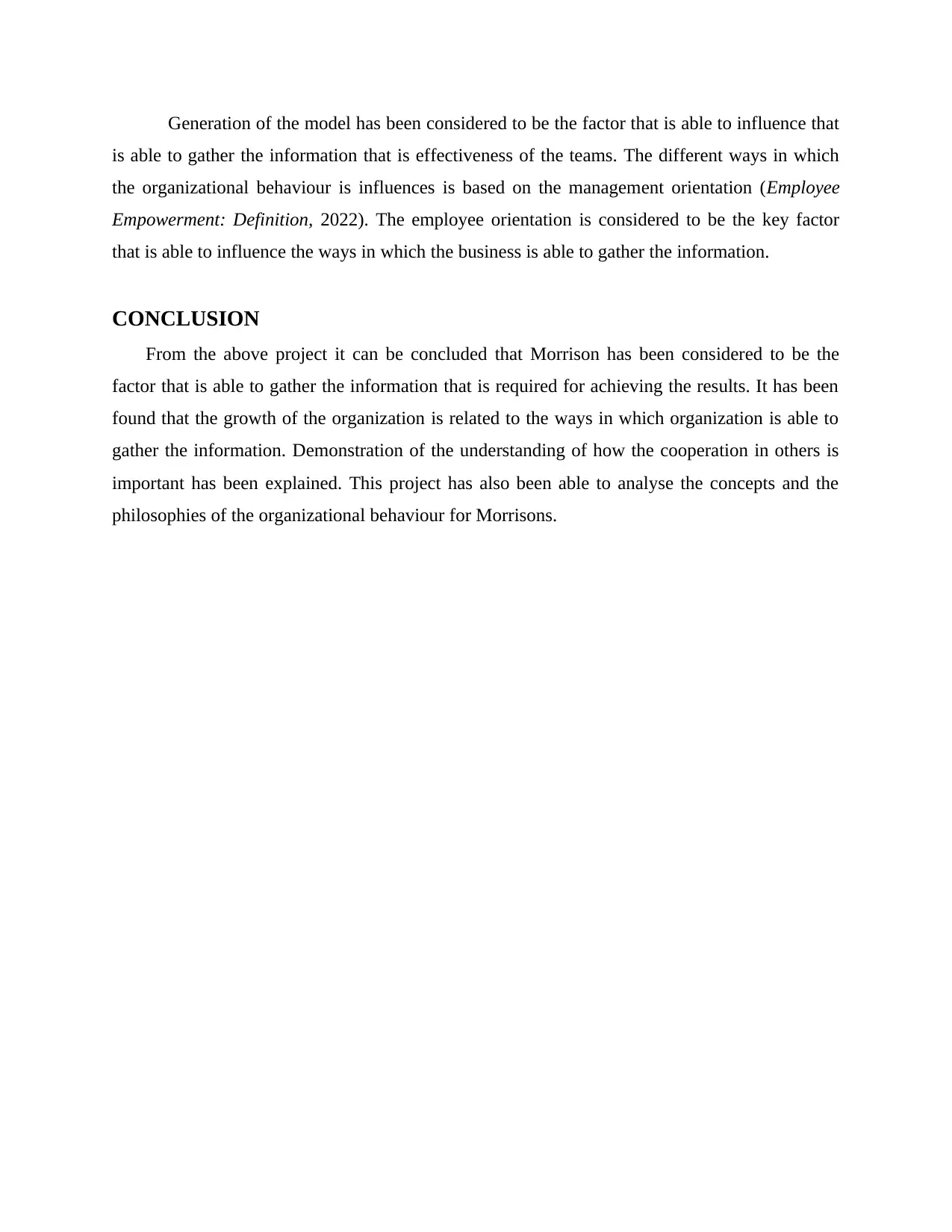
Generation of the model has been considered to be the factor that is able to influence that
is able to gather the information that is effectiveness of the teams. The different ways in which
the organizational behaviour is influences is based on the management orientation (Employee
Empowerment: Definition, 2022). The employee orientation is considered to be the key factor
that is able to influence the ways in which the business is able to gather the information.
CONCLUSION
From the above project it can be concluded that Morrison has been considered to be the
factor that is able to gather the information that is required for achieving the results. It has been
found that the growth of the organization is related to the ways in which organization is able to
gather the information. Demonstration of the understanding of how the cooperation in others is
important has been explained. This project has also been able to analyse the concepts and the
philosophies of the organizational behaviour for Morrisons.
is able to gather the information that is effectiveness of the teams. The different ways in which
the organizational behaviour is influences is based on the management orientation (Employee
Empowerment: Definition, 2022). The employee orientation is considered to be the key factor
that is able to influence the ways in which the business is able to gather the information.
CONCLUSION
From the above project it can be concluded that Morrison has been considered to be the
factor that is able to gather the information that is required for achieving the results. It has been
found that the growth of the organization is related to the ways in which organization is able to
gather the information. Demonstration of the understanding of how the cooperation in others is
important has been explained. This project has also been able to analyse the concepts and the
philosophies of the organizational behaviour for Morrisons.
Paraphrase This Document
Need a fresh take? Get an instant paraphrase of this document with our AI Paraphraser
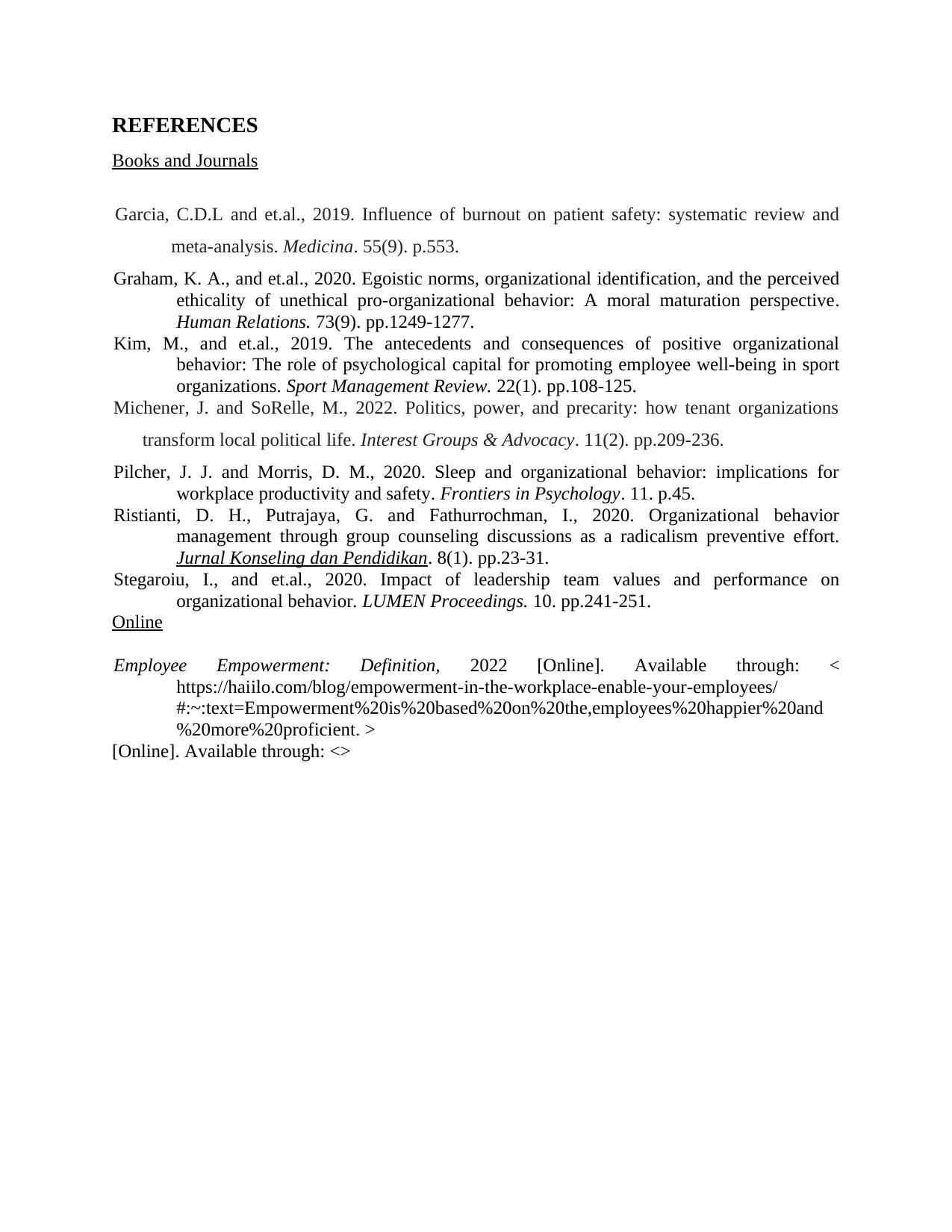
REFERENCES
Books and Journals
Garcia, C.D.L and et.al., 2019. Influence of burnout on patient safety: systematic review and
meta-analysis. Medicina. 55(9). p.553.
Graham, K. A., and et.al., 2020. Egoistic norms, organizational identification, and the perceived
ethicality of unethical pro-organizational behavior: A moral maturation perspective.
Human Relations. 73(9). pp.1249-1277.
Kim, M., and et.al., 2019. The antecedents and consequences of positive organizational
behavior: The role of psychological capital for promoting employee well-being in sport
organizations. Sport Management Review. 22(1). pp.108-125.
Michener, J. and SoRelle, M., 2022. Politics, power, and precarity: how tenant organizations
transform local political life. Interest Groups & Advocacy. 11(2). pp.209-236.
Pilcher, J. J. and Morris, D. M., 2020. Sleep and organizational behavior: implications for
workplace productivity and safety. Frontiers in Psychology. 11. p.45.
Ristianti, D. H., Putrajaya, G. and Fathurrochman, I., 2020. Organizational behavior
management through group counseling discussions as a radicalism preventive effort.
Jurnal Konseling dan Pendidikan. 8(1). pp.23-31.
Stegaroiu, I., and et.al., 2020. Impact of leadership team values and performance on
organizational behavior. LUMEN Proceedings. 10. pp.241-251.
Online
Employee Empowerment: Definition, 2022 [Online]. Available through: <
https://haiilo.com/blog/empowerment-in-the-workplace-enable-your-employees/
#:~:text=Empowerment%20is%20based%20on%20the,employees%20happier%20and
%20more%20proficient. >
[Online]. Available through: <>
Books and Journals
Garcia, C.D.L and et.al., 2019. Influence of burnout on patient safety: systematic review and
meta-analysis. Medicina. 55(9). p.553.
Graham, K. A., and et.al., 2020. Egoistic norms, organizational identification, and the perceived
ethicality of unethical pro-organizational behavior: A moral maturation perspective.
Human Relations. 73(9). pp.1249-1277.
Kim, M., and et.al., 2019. The antecedents and consequences of positive organizational
behavior: The role of psychological capital for promoting employee well-being in sport
organizations. Sport Management Review. 22(1). pp.108-125.
Michener, J. and SoRelle, M., 2022. Politics, power, and precarity: how tenant organizations
transform local political life. Interest Groups & Advocacy. 11(2). pp.209-236.
Pilcher, J. J. and Morris, D. M., 2020. Sleep and organizational behavior: implications for
workplace productivity and safety. Frontiers in Psychology. 11. p.45.
Ristianti, D. H., Putrajaya, G. and Fathurrochman, I., 2020. Organizational behavior
management through group counseling discussions as a radicalism preventive effort.
Jurnal Konseling dan Pendidikan. 8(1). pp.23-31.
Stegaroiu, I., and et.al., 2020. Impact of leadership team values and performance on
organizational behavior. LUMEN Proceedings. 10. pp.241-251.
Online
Employee Empowerment: Definition, 2022 [Online]. Available through: <
https://haiilo.com/blog/empowerment-in-the-workplace-enable-your-employees/
#:~:text=Empowerment%20is%20based%20on%20the,employees%20happier%20and
%20more%20proficient. >
[Online]. Available through: <>
1 out of 8
Related Documents
Your All-in-One AI-Powered Toolkit for Academic Success.
+13062052269
info@desklib.com
Available 24*7 on WhatsApp / Email
![[object Object]](/_next/static/media/star-bottom.7253800d.svg)
Unlock your academic potential
Copyright © 2020–2025 A2Z Services. All Rights Reserved. Developed and managed by ZUCOL.




